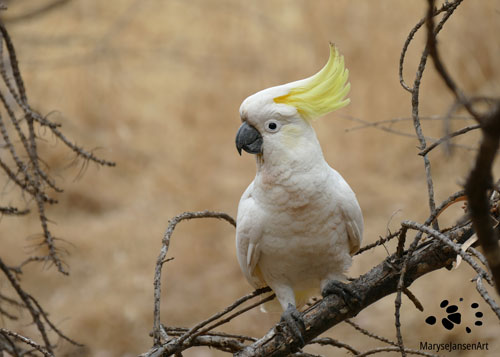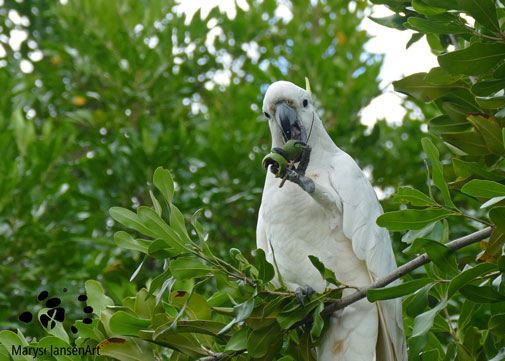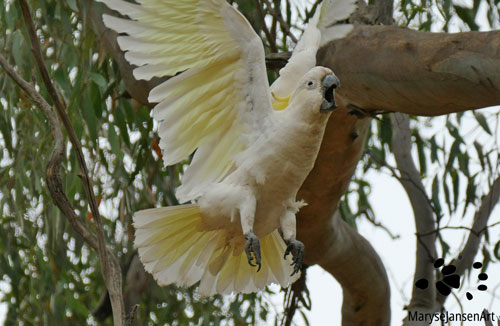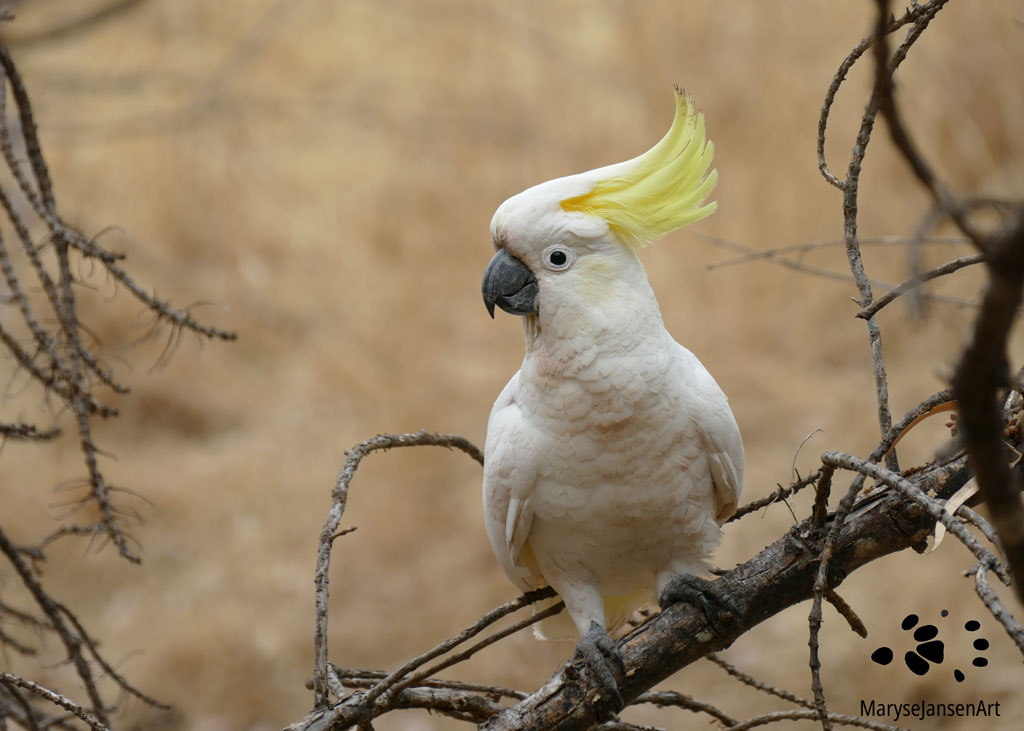Bird Photography with marysejansenart
Screeching bird cracks the toughest nut in the world with ease!

Table of Contents
The call of the Sulphur-crested Cockatoo
‘What does the bird say?’ the European grandmother asked her 5 year old Australian born grandchild. In reply the child let out a horrific screech. She laughed and said: ‘No, the bird says ‘tweet tweet tweet’!’ But the child was adamant: ‘No granny, the bird says: ….’ and a few more screeches followed. The grandmother looked confused and glanced at her daughter for help. The daughter confirmed that the child was correct: ‘This is the sound of our beautiful Sulphur-crested Cockatoos!’
The screeches of a flock of Cockatoos flying overhead has become an almost daily experience for me since moving to Australia. I have come to love the sound as it’s one of those things that remind me of where I am. It symbolizes this beautiful country that I moved to all the way from the other side of the world where the birds say ‘tweet tweet tweet’! The Laughing Kookaburra’s call is another one that does that for me!
Check out my article ‘Hunt for Happiness Nature Walk’ for more on how sounds make us feel connected to our natural environment.
The Sulphur-crested Cockatoo is a large cockatoo that can be found throughout large parts of northern and eastern Australia. Their loud, screeching call is designed to carry through the forested areas where they naturally live. This way they can communicate and stay in touch with their social group.
Their beautiful sulphur-yellow crest is another means of communication for them. It reflects their state of mind. When excited or alarmed, the crest will rise up, all the way over their head. When they feel calm or unwell, the crest will be flattened against their head. In the featured image it is in between those extremes. This Cockatoo is alert, but not stressed. It’s keeping an eye on me but I’m far away enough to not cause alarm.
Feeding Behaviour
The Cockies (which is the abbreviation Australians often use) feed on seeds, nuts, roots, berries and sometimes insects and their larvae. They often feed on ground level, where they are vulnerable to predators. Their social group is important to them to stay out of danger when feeding. While the group is feeding, a couple of birds will perch on a higher branch on the lookout for danger. If they spot a snake or a large raptor they will let out a piercing warning cry upon which all the birds take flight. They will often circle around and make a big racket until the danger has passed. Then they descend again and continue feeding.
Maintaining a strong beak
Have you ever seen Cockatoos breaking branches of the trees? I’m watching a number of Cockatoos doing just that! Quite large branches are dropping down to the ground and the Cockatoos don’t seem to have any interest in them after that. I wonder why they do it…
It turns out that they break branches and leaves of trees in order to keep their beak trimmed and not growing too large. This is important because their beak is a very important tool in obtaining their food!
Because seeds and nuts are an important part of their diet, they need a strong beak to be able to crack the shells. They have a very interesting technique. First, the pincer-like beak pierces the shell of the seed or nut. Then their flexible tongue extracts the kernel or nut from the shell and the bird drops the broken shell to the ground. They are able to store uneaten seeds in their beak while opening the next one!
Cracking a Macademia Nut!
Have you ever tried cracking a Macademia nut? This native Australian nut has the hardest nutshell in the world! Impossible to crack with any traditional nutcracker! Even with a hammer you may not have an easy time. When I first visited Australia I tried this myself during a Macademia-tour. There we were, all smashing away with big hammers on little nuts in very large stone bowls. A lot of us didn’t succeed. And even if we did the result wasn’t so great as the nut would often get smashed along with its shell. So thankfully some clever people have designed special Macademia-cracking tools.
But the Sulphur-crested Cockatoo I’m looking at here doesn’t need those tools. Almost effortlessly it sits there, in a Macademia Tree, leisurely cracking the nuts with its beak. I’m really impressed!

Relationship between Cockatoos and people
It’s not hard to imagine that with these super strong beaks the Cockatoos are quite capable of doing serious damage, chewing on wooden and even metal structures (as people who have tried to keep them in a cage would know)! Like the Australian White Ibis, these birds are loved by some and not so much by others. On the one hand, they can damage grain crops by picking all the seeds of the halms and make the grain farmers very unhappy. On the other hand they can pick undigested grains from cattle droppings. This breaks up the droppings which helps release nutrients into the soil and more grass to grow, thus making the cattle farmers very happy!
Sulphur-crested Cockatoos are highly intelligent birds. They have adapted well to living in the human environment, which sometimes causes problems. Mostly, people tend to like them as they can become quite tame around humans. Wild Cockatoos have been known to eat from people’s hands and land on their shoulders once they’ve decided you are no threat.
Their learning-capacity has been said to resemble that of a 1-2 year old child. They are inquisitive and are capable to pass on acquired knowledge to each other. As they are excellent mimicking birds they are also able to learn to talk!
Lifespan and family-life
Sulphur-crested Cockatoos can live for several decades in the wild and up to an amazing 100 years in captivity!
They have strong family relationships between them. A pair tends to mate for life. They build the nest, incubate the eggs and care for the chicks together. They nest in a tree hollow, preferably near water. It takes 70 days before the chicks are ready to leave the nest.
Around age 5 the youngsters reach sexual maturity. Both sexes look very much alike, but when the birds are sexually mature you can see a slight different in eye colour. From a distance, their eyes look black, but close-up it’s possible to see that the male has a dark-brown iris and the female a lighter reddish-coloured iris.
They may have matured but the birds remain in their family group indefinitely! As a result a flock of Cockatoos will contain several generations!

Join me on my walk in the latest episode of ‘Come for a walk in the Australian Bush’ and witness how the birds look out for each other in their family group!
If you are interested in purchasing ‘Sulphur-crested Cockatoo perched on a Branch’ or would like to see what the image looks like on the various products, please head to my shop. If you’d prefer ‘Cracking a Tough Nut’, click shop here.


